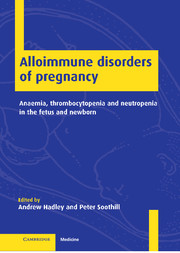 Alloimmune Disorders of Pregnancy
Alloimmune Disorders of Pregnancy Published online by Cambridge University Press: 26 October 2009
Introduction
The clinical management of alloimmunized pregnancies relies on the use of laboratory assays first to screen for the presence of blood group antibodies and then, once detected, to forecast their potential clinical significance. Screening is discussed in Chapter 3. This chapter considers laboratory tests that measure or characterize blood group antibodies in an attempt to forecast the severity of fetal haemolysis and to identify those cases where amniocentesis or percutaneous fetal umbilical cord blood sampling may be warranted in order to determine more directly the extent of fetal haemolysis. These invasive procedures carry risks, such as transplacental haemorrhage leading to exacerbation of maternal alloimmunization and the worsening of fetal anaemia (Chapter 10). It is important, therefore, that laboratory assays should reliably predict disease severity because failure to do so will expose some pregnancies to these risks unnecessarily.
Numerous techniques have been developed to predict the severity of HDFN. These assays may be serological, quantitative or cellular in nature. In all cases, the aim is to establish thresholds of antibody activity or trends in activity which are predictive of fetal haemolysis. This chapter discusses the advantages and limitations of these approaches, emphasizing the need for a structured and sequential application of assays of increasing complexity in order to generate clinically useful information in a cost-effective manner.
Serological assays
The majority of antibodies which cause HDFN do not agglutinate red cells suspended in saline.
To save this book to your Kindle, first ensure [email protected] is added to your Approved Personal Document E-mail List under your Personal Document Settings on the Manage Your Content and Devices page of your Amazon account. Then enter the ‘name’ part of your Kindle email address below. Find out more about saving to your Kindle.
Note you can select to save to either the @free.kindle.com or @kindle.com variations. ‘@free.kindle.com’ emails are free but can only be saved to your device when it is connected to wi-fi. ‘@kindle.com’ emails can be delivered even when you are not connected to wi-fi, but note that service fees apply.
Find out more about the Kindle Personal Document Service.
To save content items to your account, please confirm that you agree to abide by our usage policies. If this is the first time you use this feature, you will be asked to authorise Cambridge Core to connect with your account. Find out more about saving content to Dropbox.
To save content items to your account, please confirm that you agree to abide by our usage policies. If this is the first time you use this feature, you will be asked to authorise Cambridge Core to connect with your account. Find out more about saving content to Google Drive.